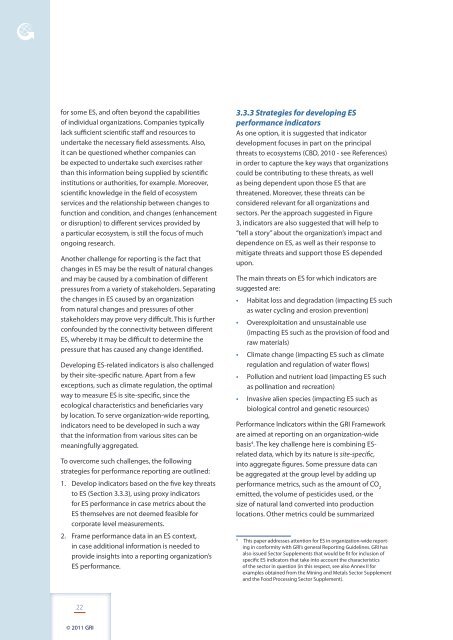Approach for reporting on ecosystem services - BIP Indicators
Approach for reporting on ecosystem services - BIP Indicators
Approach for reporting on ecosystem services - BIP Indicators
Create successful ePaper yourself
Turn your PDF publications into a flip-book with our unique Google optimized e-Paper software.
Sustainability Reporting Today: The Readers’ Verdict<str<strong>on</strong>g>for</str<strong>on</strong>g> some ES, and often bey<strong>on</strong>d the capabilitiesof individual organizati<strong>on</strong>s. Companies typicallylack sufficient scientific staff and resources toundertake the necessary field assessments. Also,it can be questi<strong>on</strong>ed whether companies canbe expected to undertake such exercises ratherthan this in<str<strong>on</strong>g>for</str<strong>on</strong>g>mati<strong>on</strong> being supplied by scientificinstituti<strong>on</strong>s or authorities, <str<strong>on</strong>g>for</str<strong>on</strong>g> example. Moreover,scientific knowledge in the field of <strong>ecosystem</strong><strong>services</strong> and the relati<strong>on</strong>ship between changes tofuncti<strong>on</strong> and c<strong>on</strong>diti<strong>on</strong>, and changes (enhancementor disrupti<strong>on</strong>) to different <strong>services</strong> provided bya particular <strong>ecosystem</strong>, is still the focus of much<strong>on</strong>going research.Another challenge <str<strong>on</strong>g>for</str<strong>on</strong>g> <str<strong>on</strong>g>reporting</str<strong>on</strong>g> is the fact thatchanges in ES may be the result of natural changesand may be caused by a combinati<strong>on</strong> of differentpressures from a variety of stakeholders. Separatingthe changes in ES caused by an organizati<strong>on</strong>from natural changes and pressures of otherstakeholders may prove very difficult. This is furtherc<strong>on</strong>founded by the c<strong>on</strong>nectivity between differentES, whereby it may be difficult to determine thepressure that has caused any change identified.Developing ES-related indicators is also challengedby their site-specific nature. Apart from a fewexcepti<strong>on</strong>s, such as climate regulati<strong>on</strong>, the optimalway to measure ES is site-specific, since theecological characteristics and beneficiaries varyby locati<strong>on</strong>. To serve organizati<strong>on</strong>-wide <str<strong>on</strong>g>reporting</str<strong>on</strong>g>,indicators need to be developed in such a waythat the in<str<strong>on</strong>g>for</str<strong>on</strong>g>mati<strong>on</strong> from various sites can bemeaningfully aggregated.To overcome such challenges, the followingstrategies <str<strong>on</strong>g>for</str<strong>on</strong>g> per<str<strong>on</strong>g>for</str<strong>on</strong>g>mance <str<strong>on</strong>g>reporting</str<strong>on</strong>g> are outlined:1. Develop indicators based <strong>on</strong> the five key threatsto ES (Secti<strong>on</strong> 3.3.3), using proxy indicators<str<strong>on</strong>g>for</str<strong>on</strong>g> ES per<str<strong>on</strong>g>for</str<strong>on</strong>g>mance in case metrics about theES themselves are not deemed feasible <str<strong>on</strong>g>for</str<strong>on</strong>g>corporate level measurements.2. Frame per<str<strong>on</strong>g>for</str<strong>on</strong>g>mance data in an ES c<strong>on</strong>text,in case additi<strong>on</strong>al in<str<strong>on</strong>g>for</str<strong>on</strong>g>mati<strong>on</strong> is needed toprovide insights into a <str<strong>on</strong>g>reporting</str<strong>on</strong>g> organizati<strong>on</strong>’sES per<str<strong>on</strong>g>for</str<strong>on</strong>g>mance.3.3.3 Strategies <str<strong>on</strong>g>for</str<strong>on</strong>g> developing ESper<str<strong>on</strong>g>for</str<strong>on</strong>g>mance indicatorsAs <strong>on</strong>e opti<strong>on</strong>, it is suggested that indicatordevelopment focuses in part <strong>on</strong> the principalthreats to <strong>ecosystem</strong>s (CBD, 2010 - see References)in order to capture the key ways that organizati<strong>on</strong>scould be c<strong>on</strong>tributing to these threats, as wellas being dependent up<strong>on</strong> those ES that arethreatened. Moreover, these threats can bec<strong>on</strong>sidered relevant <str<strong>on</strong>g>for</str<strong>on</strong>g> all organizati<strong>on</strong>s andsectors. Per the approach suggested in Figure3, indicators are also suggested that will help to“tell a story” about the organizati<strong>on</strong>’s impact anddependence <strong>on</strong> ES, as well as their resp<strong>on</strong>se tomitigate threats and support those ES dependedup<strong>on</strong>.The main threats <strong>on</strong> ES <str<strong>on</strong>g>for</str<strong>on</strong>g> which indicators aresuggested are:• Habitat loss and degradati<strong>on</strong> (impacting ES suchas water cycling and erosi<strong>on</strong> preventi<strong>on</strong>)• Overexploitati<strong>on</strong> and unsustainable use(impacting ES such as the provisi<strong>on</strong> of food andraw materials)• Climate change (impacting ES such as climateregulati<strong>on</strong> and regulati<strong>on</strong> of water flows)• Polluti<strong>on</strong> and nutrient load (impacting ES suchas pollinati<strong>on</strong> and recreati<strong>on</strong>)• Invasive alien species (impacting ES such asbiological c<strong>on</strong>trol and genetic resources)Per<str<strong>on</strong>g>for</str<strong>on</strong>g>mance <strong>Indicators</strong> within the GRI Frameworkare aimed at <str<strong>on</strong>g>reporting</str<strong>on</strong>g> <strong>on</strong> an organizati<strong>on</strong>-widebasis 4 . The key challenge here is combining ESrelateddata, which by its nature is site-specific,into aggregate figures. Some pressure data canbe aggregated at the group level by adding upper<str<strong>on</strong>g>for</str<strong>on</strong>g>mance metrics, such as the amount of CO 2emitted, the volume of pesticides used, or thesize of natural land c<strong>on</strong>verted into producti<strong>on</strong>locati<strong>on</strong>s. Other metrics could be summarized4This paper addresses attenti<strong>on</strong> <str<strong>on</strong>g>for</str<strong>on</strong>g> ES in organizati<strong>on</strong>-wide <str<strong>on</strong>g>reporting</str<strong>on</strong>g>in c<strong>on</strong><str<strong>on</strong>g>for</str<strong>on</strong>g>mity with GRI’s general Reporting Guidelines. GRI hasalso issued Sector Supplements that would be fit <str<strong>on</strong>g>for</str<strong>on</strong>g> inclusi<strong>on</strong> ofspecific ES indicators that take into account the characteristicsof the sector in questi<strong>on</strong> (in this respect, see also Annex II <str<strong>on</strong>g>for</str<strong>on</strong>g>examples obtained from the Mining and Metals Sector Supplementand the Food Processing Sector Supplement).22© 2011 GRI



